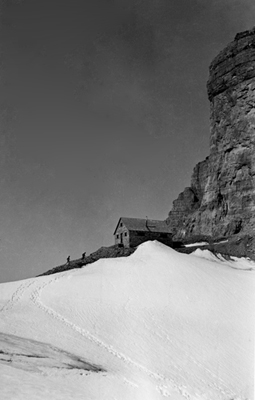Abbot Pass Refuge Cabin National Historic Site of Canada
Banff National Park of Canada, Alberta

Simple massing as one-and-a-half-storey rectangle
© Parks Canada Agency / Agence Parcs Canada, 1930.
Address :
Abbot Pass, Banff National Park of Canada, Alberta
Recognition Statute:
Historic Sites and Monuments Act (R.S.C., 1985, c. H-4)
Designation Date:
1992-11-06
Dates:
-
1922 to 1922
(Construction)
Other Name(s):
-
Abbot Pass Refuge Cabin
(Designation Name)
-
Abbot Pass Hut
(Plaque name)
Research Report Number:
RUSTIC BLDGS - 1992; P 1992-A02; SUA; SUB
DFRP Number:
15404 00
Plaque(s)
Existing plaque: Banff National Park of Canada, Alberta
Built in 1922, this sturdy shelter is a unique and enduring monument to the Swiss guides, who first came to the Rocky Mountains in 1897 under the auspices of the Canadian Pacific Railway. It was patterned on examples in the Swiss Alps. All materials, apart from the stone, were carried by pack horses past the Lower Victoria Glacier, then by the guides to the pass summit. Never again was such an arduous feat undertaken in the national parks. The shelter has served as a high-altitude base for generations of climbers, here in the cradle of Canadian mountaineering.
Description of Historic Place
Abbot Pass Refuge Cabin is a high altitude alpine shelter in Abbot Pass, a col between Mounts Lefroy and Victoria on the continental divide on the border between Banff and Yoho National Parks. Its simple rectangular form and unadorned stone construction speaks to the rigors of its high altitude setting. The cabin is operated by the Alpine Club of Canada as a shelter for mountaineers.
Heritage Value
Abbot Pass Refuge Cabin was declared a National Historic Site in 1992 because it is constructed in the rustic design tradition, it is associated with outdoor recreation in the national park.
The heritage value of this site resides in its physical expression of rustic design as well as in its traditional use by visitors to the park. Built under the sponsorship of the Canadian Pacific Railway in 1922, it was acquired by the Parks Branch in 1968 and restored in 1973. Since 1985, the hut has been maintained and operated by the Alpine Club of Canada.
Source: Historic Sites and Monuments Board of Canada, November 1992 Minutes; Commemorative Integrity Statement, January 2002
Character-Defining Elements
Elements which characterize the heritage value of this building include: its picturesque siting in a barren and remote mountain pass above the tree line; its simple massing as one-and-a-half-storey rectangle under a pitched roof; its balanced articulation of central door with flanking windows, apex window, regularly articulated side windows, the limited number and relatively small size of openings; its use of local, split stone in load-bearing wall construction technology; its use of wooden roof framing, shingles, and prefabricated doors and windows; the functional layout of the interior with a kitchen/dining and sleeping areas, reflecting its use as a mountain shelter; the harmony of the building with its setting (the similar hues of building stone and surrounding rock, the building's siting, nestled in the contours of the surrounding terrain); its viewplanes along Abbot Pass and to trails from Banff and Yoho National Parks; its use as a shelter by the public, particularly mountaineers.